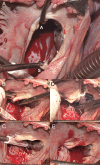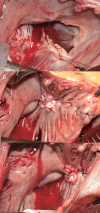Absence of posterior tricuspid valve leaflet and valve reconstruction
- PMID: 22419794
- PMCID: PMC3352735
- DOI: 10.1093/icvts/ivs082
Absence of posterior tricuspid valve leaflet and valve reconstruction
Abstract
We report a rare case of the absence of a posterior tricuspid valve leaflet. A male patient, aged 46, suffering from severe tricuspid valve regurgitation (TR) of unknown aetiology and atrial septal aneurysm was referred to our hospital for surgery. On surgical inspection, the posterior tricuspid valve leaflet and its subvalvular apparatus were completely absent and only the valve annulus was seen in the corresponding position. The anterior and septal leaflets were normal. We successfully reconstructed the tricuspid valve as follows: the head of an anterior papillary muscle was approximated to the ventricular septum (Sebening stitch). After the approximation of the centre of the tricuspid annulus of the anterior leaflet to the tricuspid annulus on the opposite side, a sizer of 29 mm in diameter was easily passed through the anterior orifice. The posterior orifice was closed with running sutures (posterior annulorrhaphy after Hetzer). Before these procedures, we attempted to reconstruct the tricuspid valve with a posterior annulorrhaphy alone; however, valve competence was insufficient. A Sebening stitch was necessary to improve the valve competence. Echocardiography showed TR grade 1 at the patient's discharge from hospital and TR grade 1 to 2 at the follow-up, 10 months after the operation.
Figures



Comment in
-
eComment. Right atrioventricular valve with congenitally absent cusp.Interact Cardiovasc Thorac Surg. 2012 Jun;14(6):885. doi: 10.1093/icvts/ivs189. Interact Cardiovasc Thorac Surg. 2012. PMID: 22589354 Free PMC article. No abstract available.
References
-
- Komoda T, Komoda S, Nagdyman N, Berger F, Hetzer R. Combination of a Hetzer operation and a Sebening stitch for Ebstein's anomaly. Gen Thorac Cardiovasc Surg. 2007;55:355–9. - PubMed
-
- Badiu CC, Schreiber C, Hörer J, Ruzicka DJ, Wottke M, Cleuziou J, et al. Early timing of surgical intervention in patients with Ebstein's anomaly predicts superior long-term outcome. Eur J Cardiothorac Surg. 2010;37:186–92. - PubMed
-
- Lapenna E, De Bonis M, Verzini A, La Canna G, Ferrara D, Calabrese MC, et al. The clover technique for the treatment of complex tricuspid valve insufficiency: midterm clinical and echocardiographic results in 66 patients. Eur J Cardiothorac Surg. 2010;37:1297–303. - PubMed
-
- Pfannmueller B, Hirnle G, Seeburger J, Davierwala P, Schroeter T, Borger MA, et al. Tricuspid valve repair in the presence of a permanent ventricular pacemaker lead. Eur J Cardiothorac Surg. 2011;39:657–61. - PubMed
Publication types
MeSH terms
LinkOut - more resources
Full Text Sources
Medical

